Confessions of a Widescreen Weekend Fan |
Read more
at in70mm.com The 70mm Newsletter |
||||||
| Written by: Thomas Hauerslev | Date: March 2003 | ||||||
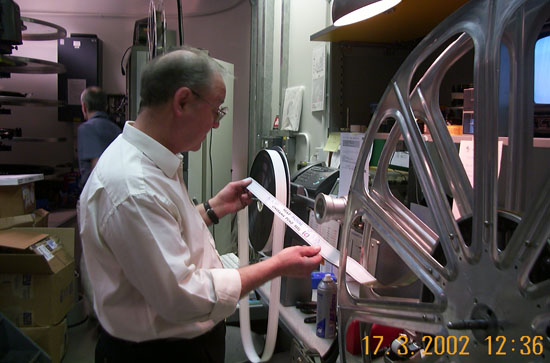 Tony
thinking "Oh I wish I was back in Leeds with 70mm - this is too
small" Tony
thinking "Oh I wish I was back in Leeds with 70mm - this is too
small"For me, Wide Screen Weekend marks the culmination of a long process. It’s the weekend where I can finally sit down, relax and enjoy myself. For a number of years, I’ve contributed to the planning of the Wide Screen Weekend by suggesting several personal picks of films and ideas to Head of Film, Mr. Bill Lawrence, chief “wrangler” of the 3½-day event. Perhaps not so well known is the fact that the WSW is only a small part of a much larger event, the annual 2-week Bradford Film Festival. Of course my part is insignificant compared to what the rest of the NMPFT staff is doing, but I enjoy being able to contribute, and I really feel privileged to be part of such a professional team. These notes will let you see a bit behind the scenes of what happens prior to the Wide Screen Weekend, and specifically 2002s event, when nearly 200 “insane” big-screen fanatics congregated to worship the wonder of wide screen. What my part comes down to is trying to be creative and still make ends meet. I do this by making phone calls, sending faxes and e-mails to people and organizations about 70mm prints. It is usually directed through official movie company channels and in some cases through a maze of people who have heard about long forgotten orphan 70mm prints in abandoned projection rooms. It’s done 4-6 months ahead of the March weekend - and it’s great fun and hard work. |
Further
in 70mm reading: Bradford, Widescreen Weekend 2002 • Gallery: 2002 • Gallery film: 2002 • WSW Home • Through the Years • The Best of WSW • Academy of the WSW • Creating the WSW • Planning the WSW • Projecting the WSW • Home of CINERAMA • Projecting CINERAMA Internet link: |
||||||
Guests |
|||||||
|
One of the nice things in particular is to be able to invite some Wide Screen celebrities to the attend the festival. Cinerama’s 50th anniversary in 2002 was to be celebrated by showing some of the films and having some of the people behind the films in attendance. Very early on I called Borden Mace (b. 1919), the producer of
“Windjammer” and “Cinerama Holiday” and Dick Babish (1918), engineer of the Cinerama camera, two obvious guests. They are both keen to travel and I had met them both previously in Dayton (OH) in 1997. Happily they accepted the invitation and were delighted to come over for the occasion. I also had good contact with Betty and Fred Troller in New York
(”Cinerama Holiday” stars). Unfortunately, they could not come as Fred was very ill, but they were delighted to have been invited. Other celebs to attend previous weekends include Louis de Rochemont (1998), Ken Annakin (1999), Morten Skallerud, Hans Kristian Bukholm and Paul Gerber (1999). |
|||||||
“Patton” and the D-150 lens |
|||||||
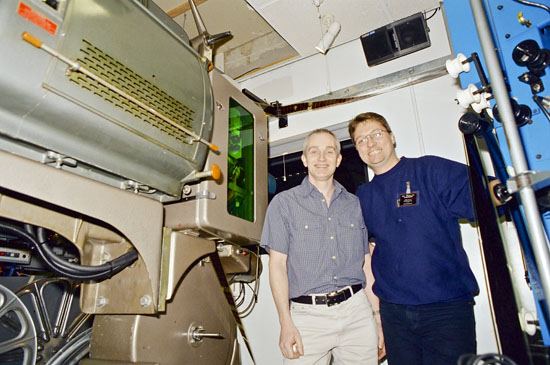 Duncan
(L) and Thomas (R). Duncan
(L) and Thomas (R).2002’s WSW theme was obvious; “Cinerama’s 50th anniversary” and I felt a presentation of some 70mm Dimension-150 films would fit in nicely because of the process’ 150 degrees of field (dwarfing Cinerama’s “humble” 146 degrees of course). My dream was to show “Patton” back to back with “The Bible…in the beginning” and the rarely seen D-150 short film “Harmony, Nature and Man”. In 2001 Fox had restored “Patton” (1970, Dimension 150) and created new 70mm prints utilizing DTS´ 70mm “special venue” digital sound technology for the soundtrack. Unlike other large format magnetic sound restorations, “Patton” was re-issued with the original 5 discrete screen channels and mono surround channel (the original 6-track Todd-AO configuration) reproduced by DTS digital. The film is again available as original heard in 1970. With help from DTS in the States and Mr. Paul Rayton at the American Cinematheque, I contacted Mr. Schawn Belston at Fox to ask permission to borrow the new 70mm print. 20th Century Fox in Hollywood was very helpful and he needed little explanation to see the potential of Pictureville and he sent us the film. |
|||||||
Richard Vetter |
|||||||
|
Dr. Richard Vetter spent a lifetime with Todd-AO and is a co-developer of the Dimension 150 process, and is still a strong advocate of 70mm. We have been on the phone countless times talking about lenses, 70mm and Todd-AO. I’ve met him twice and Dick has been a subscriber to The 70mm Newsletter from day 1 and I feel very privileged to know him. He has always been extremely supportive and when I asked him about donating a D-150 projection lens to the Pictureville
cinema back in 1999, he enthusiastically sent us one. To calculate the correct focal length lens, Dick requested some very specific measurements of the screen size, chord, depth, height, aperture size and projection distance. Duncan and Tony organized the measurements down to the inch. |
|||||||
Pictureville Screen Measurements |
|||||||
|
|||||||
|
|||||||
|
|||||||
|
I invited Dick Vetter to be our guest of honour, but at the last moment he had to cancel for personal reasons. In the end, only “Patton” was shown in D-150. At least officially; as all other 70mm films shown on the deep curve Cinerama screen were projected using the D-150 lens. |
|||||||
“2001: A Space Odyssey” |
|||||||
|
In 2001 THE obvious film to show at the Wide Screen Weekend was of course Stanley Kubrick´s
“2001:A Space Odyssey”. Having no idea about any re-release schedule I thought the best and obvious approach was to call Warner Brothers in London and ask them. I was quickly put through to Mr. Julian Senior and he asked me to call Mr. Leon Vitali, Stanley Kubrick’s personal assistant for many years. Leon was in Hollywood on business and I caught him on his cell phone in his car. Some months earlier he’d already explained how the
“2001: A Space Odyssey” soundtrack had been re-recorded, at Todd-AO in Hollywood. I was happy to talk to him again and he seemed to be pleased that we wanted to show the film. He was very positive when I explained Pictureville’s Cinerama
screen and
Dimension 150 combination to him. I asked him to give the British distributor of the film a gentle “push” to re-release it in Bradford. As events turned out
“2001: A Space Odyssey” was to be re-released just as “our” festival was ready to go, so that perhaps made it a bit easier. |
|||||||
Friday, Getting ready for departure |
|||||||
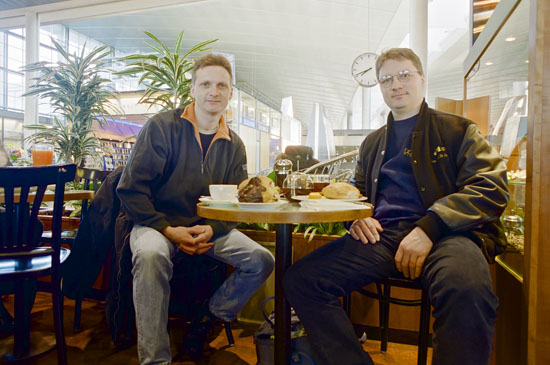 Henrik
Hellstern-Hauerslev (L) and Thomas Hauerslev Henrik
Hellstern-Hauerslev (L) and Thomas Hauerslev Finally, it was departure time. The tickets had been bought on a rainy day in November and the hotel room had been booked months ago. I got up at 5am, had some breakfast and a cup of tea. Everyone else in the house were still asleep. My luggage had been packed days ahead. I travel light and will only bring the most essential things: toothbrush, toothpaste and my glasses. Oh yes, then there’s all the notes, my camera(s), passport, ticket, my VISA card and some extra clothes. In the airport I usually buy two dozen beers. One box for myself and another for the hard working projectionists. This way I “fly” through passport checks and don’t spend time waiting for luggage. The past 3 years I’ve flown from Copenhagen to Manchester. It’s very convenient for me because the public transportation at both ends are perfect. 2002 was especially pleasant for me because my brother Henrik, also a 70mm fan and film buff, was accompanying me to Bradford. His first WSW was in 1997; this is his second time around. Less than two hours after a sunny CPH take-off, we are waiting for a train in Manchester airport railway station, bound for Bradford (change in Leeds). 2 hours later, we find ourselves in the Pennington hotel foyer around 12:30. Not too bad considering I woke up 8-9 hours earlier, 5 am in Denmark. |
|||||||
|
|||||||
|
The Pennington is a very nice and comfortable hotel. The breakfast is superb and the rooms I’ve stayed in have always been clean and quiet. The price for three nights in a double room is also acceptable, less than £80 Pounds including WSW discount. The hotel is situated almost on top of Forster Sq. station, and It’s only a 10-minute walk to the Pictureville cinema through the city center. After some shopping in the VIRGIN mega store and HMV we meet Bill at the museum. Henrik brought him a box of Danish movie posters for the museum’s collection. We have finally arrived, four months after buying the tickets on that gray November day in Copenhagen. It’s good to be back in Bradford, and in the new museum restaurant, we met some friends from previous years. It’s like meeting family members when you go abroad year after year to see films again and again. Somehow it´s life-affirming to travel to another country to see films together with the old chums from last year again. |
|||||||
“This is Cinerama” |
|||||||
|
We didn’t see “TIC” this time around. Instead we saw
“Shakelton’s Arctic Adventure” in IMAX. One of the best IMAX films yet made. What I liked about it was the way the story was told using the large format intercut with original 35mm b/w footage. It could have been told through 8mm but it would have lost the visual impact. And the film didn’t carry the usual IMAX “ecological messages” at all. |
|||||||
Wide Screen Welcome for the weekend delegates |
|||||||
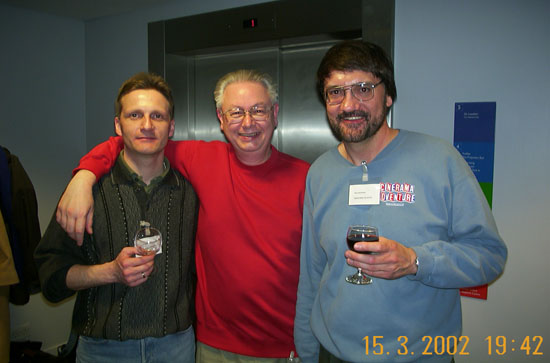 Henrik,
David Page and Dave Strohmaier Henrik,
David Page and Dave StrohmaierWell attended with wine and snacks. A good get-together and a nice opportunity to meet fellow guests and make some introductions. Celebs Dave Strohmaier, Borden and Dick were there to meet the “congregation” of Cinerama devotees that included Torkel Sætervadet, John Belton, Wolfram Hannemann, Ingolf Vonau, Peter Andren, Jan Olsen, Malcolm Clarke, Andrew King, Chris O´Kane, Wouter de Voogd, Johan Wolthuis, Barrie Pick, Serge Bosschaerts, David Page, Francois Carrin, Paul Rayton and many more. |
|||||||
“2001:A Space Odyssey” |
|||||||
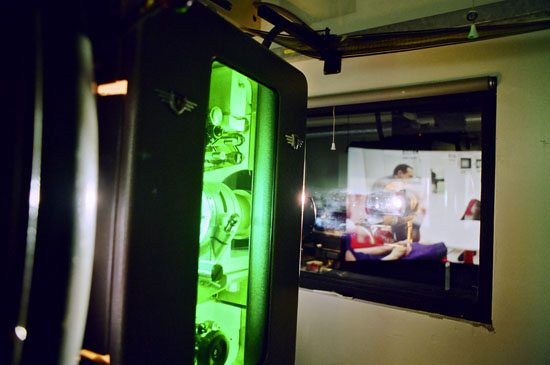 My
favorite picture subject, trying to capture the essence of being a
projectionist. My
favorite picture subject, trying to capture the essence of being a
projectionist.Wide Screen Weekend is for one weekend a home to a dedicated crowd of film fans. But in order to attract a contemporary audience, some “mainstream” films have to be shown too, to make ends meet financially. “2001” is one such film. Bill and I had dedicated the first evening performance of the 2002 WSW to honour the memory of Steen S. Larsen. Steen was killed in the Milan plane crash October 8, 2001. I was asked to represent him to introduce Stanley Kubrick´s “2001:A Space Odyssey”. It was a moving and exciting moment for me. The back-story is that Steen and I had been able to bring about a couple of historic “toys” for the museum. Plagued by focus problems, the original Cinemeccanica Victoria 8 machine wasn’t living up to my expectations and I felt the only solution was to install a DP70 – “the only time-proven 70mm projector” – to quote the 60s catch phrase. Problems were especially evident during 1998’s Wide Screen Weekend, when “The King and I” was shown on both screens (switched during intermission) in a valiant effort to eliminate focus problems, but to no avail. The following summer I had asked Steen Larsen of Nordisk Film in Copenhagen about possibly donating a surplus DP70 to the museum in Bradford. Steen was very positive, and in November the same year, a DP70 arrived on the NMPFT door step. The idea was to have the DP70 installed next to the Vic 8 for 1999’s Wide Screen Weekend. But it wasn’t until 2002 that, the machine ran the first public performance. I had known Steen since 1983 and I’m positive he would have liked to introduce this particular “2001” performance himself. The performance was Pictureville’s first public performance with the DP70. Steen, always a perfectionist, would have been a happy man if he could have seen how good “2001:A Space Odyssey” looked on the magnificent Cinerama curve. The performance was a complete sellout and in the audience were Borden, Dick and Dave. I didn´t see the film this year, but Henrik did. I lurked around in the projection room taking pictures and making sure the DP70 was running as it was supposed to do (I´m mad; I should see the film, go to bed or drink some beers). It’s odd, the film is only 2:19, but it has an intermission, which gives me a sense of a long feature. Many films today have a longer running time and no intermission. |
|||||||
About introductions |
|||||||
|
If any among the audience would like to introduce a film or to say something before a film, you are most welcome. Just let Bill or me know, and it can be arranged. |
|||||||
After hours at the hotel #1 |
|||||||
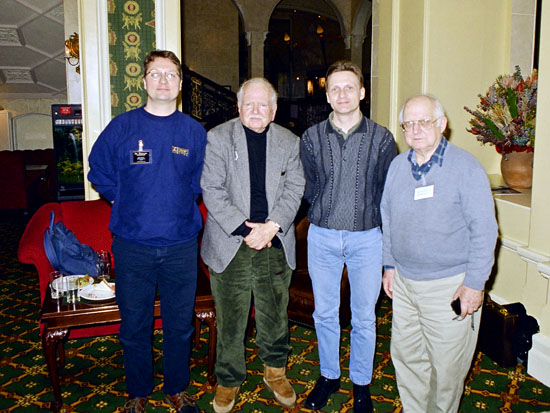 Myself,
Borden, Henrik and Dick Myself,
Borden, Henrik and DickAfter “2001:A Space Odyssey” Henrik and I went back to our hotel. In the bar we ran into Borden Mace and Dick Babish. We sat down, had beers and a lovely chat about Cinerama and Cinemiracle. It became very late, but the stories were worth waiting for. Borden told the untold secret of how the “Christian Radich”, star of the film “Windjammer”, was towed into Skagen harbor (Denmark) in the middle of the night by the royal Danish Navy. Very embarrassing for the Norwegians in those days. |
|||||||
Saturday, Academy of the Wide Screen Weekend |
|||||||
|
I had been honored in 2001 by being enrolled to the
grand order of the Wide Screen Weekend “for exceptional service to 70mm and Cinerama”, joining fellow academians Mr. Howard Rust and Mr. John Belton. It was indeed a big moment for me and I was very proud to be in their company. Like Groucho Marx I would never accept to be a member of a club which would have me as a member! But in this case I made an exception. Anyway, among the Academy members duties are to ensure that the membership grows year by year. We discussed a few names and finally decided on one person. We selected Mr. Willem Bouwmeester for his outstanding contribution to preserving Cinerama history and in particular his influence on Pictureville cinema, which for so many people, has become the second birthplace for Cinerama. Howard went home and wrote the pages I was supposed to read the following day. |
|||||||
"Cinerama Holiday" |
|||||||
|
It turned out to be a day without Bill who had been struck with the flu. Dick Vaughan and I quickly decided on a “quick and dirty” plan to introduce the films. I introduced
“Cinerama Holiday” by saying good morning to the audience and then handed the microphone to Borden and Dick. Dick remarked the audience he was afraid nobody would turn up to see the film. Before the film, a short newsreel of the actual opening of the film was shown. Running commentary was ad-libbed by Borden Mace. “Cinerama Holiday” starts off with a prologue in 4:3 and then after a few minutes suddenly the screen opens to full 3-strip width. This morning there was a slight glitch as the centre panel (B), was mirrored/flipped. It was quite funny to watch of course, but must have been rather frustrating for the crew in projection. Of course the film had to be stopped and the waiting time filled by a - - well - - breakdown film! What else, it’s all part of the show. Only this time, the breakdown film was in colour, or at least it wasn’t completely pink. The pink nuance is lovingly known as “The Official Cinerama Colour”. Lowell Thomas, in his own charming 1950s way, explained the technicalities of Cinerama, and every once in a while looked up hopefully towards the projection to see if they were ready. Much to the amusement of the audience. |
|||||||
Cinerama Technical Seminar with camera #1 |
|||||||
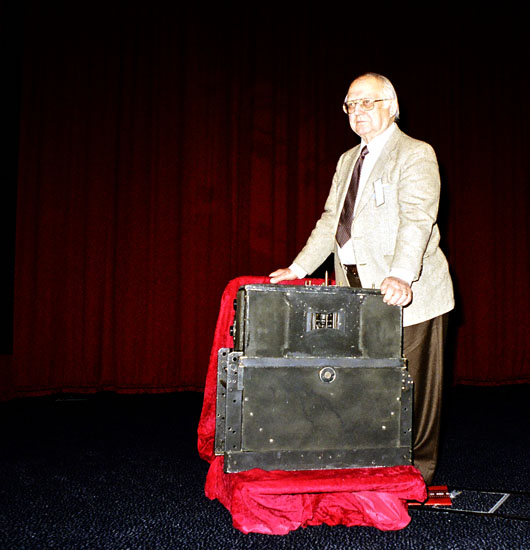 Dick
and his camera reunited Dick
and his camera reunitedFor a number of years the NMPFT has had Cinerama camera #1 on display in the foyer. As Cinerama history is finally becoming of interest to the good folks in the States, it has to go back again from it’s 2nd voyage to Europe. With this in mind, the camera was put on stage for everyone to have a last look. Next to the camera was Dick Babish, who engineered the contraption 50+ years ago. Because Bill had taken ill, nobody really knew what was supposed to take place, so I became some sort of moderator for a Q&A between the audience and the panel. The panel consisted of Joe Dunton, Borden and Dick. In the end, it was mostly Dick who enthusiastically answered questions from the audience about Cinerama history. |
|||||||
"How the West Was Won" in Cinerama |
|||||||
|
I didn’t see it. Instead Henrik and I saw
“3D Mania” in IMAX and then "The Big Trail" (Fox 1930) at the Cobby Broccoli cinema. Originally filmed in 65mm Grandeur, the print we saw was in 35mm. The performance was well attended. It was black and white with a rather poor sound track. The print was a somewhat scratched archive print. The show was delayed while waiting for the
"How the West Was Won" audience. |
|||||||
"Patton" in Dimension-150 and 70mm DTS |
|||||||
|
For me the last performance of Saturday was also the highlight of the weekend: to see
"Patton" presented in Dimension-150 with the real Super Curvulon lens on a curved screen. This has always been on my wish list, as I am too young to have seen the film originally. Previously I’d only seen it on laserdisc, which of course is only a souvenir of the real thing. The film was good on laser, but in D-150, it was splendid. It looked magnificent on the curve. The new 70mm print was stunning and the rock-steady 70mm images were all any wide screen devotee could wish for. It was 70mm at it’s absolute best. The sound was very smooth in its discrete 6-track stereo Todd-AO configuration. I had the pleasure of introducing the film and read a short message from Dick Vetter himself. For some unknown reason the end titles were cut which was a bit disappointing. In any case with the Super Curvulon lens, the DP70 and the Cinerama screen, Pictureville cinema must be the only cinema in the world equipped to present “Patton” in Dimension–150 as originally intended. |
Dick's
message: "It is a big disappointment for me not to be able to join the "Patton" screening at Pictureville. Although the production dates back 33 years, it ranks amongst the top films and has well stood the test of time. It was indeed a privilege to work with so many talented people. I know all of you tonight will enjoy the presentation immensely. With my best regards, Dick Vetter." |
||||||
After hours at the hotel #2 |
|||||||
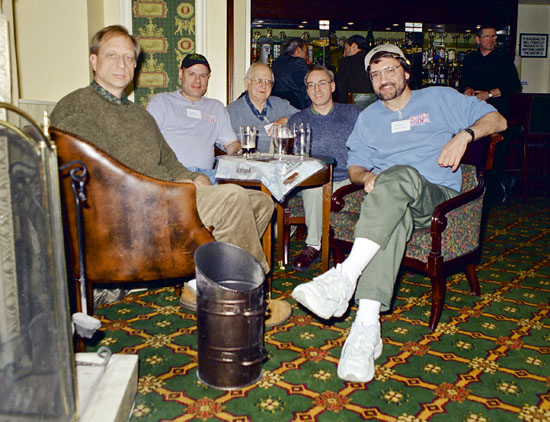 Dave
Strohmaier (R) and his "gang". Greg Kimble (L), Randy Gitsch,
Dick Babish and Chris O'Kane Dave
Strohmaier (R) and his "gang". Greg Kimble (L), Randy Gitsch,
Dick Babish and Chris O'KaneOnce again Henrik and I sat down in the hotel bar to have a quiet beer after the last performance. We met Dave Strohmaier’s group once again. Dave was with the “Cinerama Adventure” producer Randy Gitsch, writer Greg Kimble and VistaScope entrepreneur Chris O’Kane. Dave entertained us all with stories about Paul Allen´s team who wanted to install electronic Cinerama projectors in the Seattle Cinerama. The engineers argued ceaselessly for electronic projectors until Dave asked them “OK, can you do 26 frames per second?”. The engineers asked, bewildered, “Why do you want to do 26 frames per second?”. That was fun, at least to my ear. Regular 35mm runs 24 frames per second, and Cinerama runs 26. The engineers so caught up in the technical challenges of “restoring cinerama”, they forgot to check the film speed. But can you really blame them? Anyway, I laughed. Sitting there talking Cinerama brought up another subject about the October 1983 American Cinematographer article about “How the West Was Won” and I mentioned this to Greg. I even quoted the ending for him (“And I swore I wasn’t going to cry”) and asked if he knew the article. “Know it? – I wrote it” he exclaimed. It was an odd coincidence to talk about an article written 20 years ago and have no idea that I was talking to the author. Legend has it that it was THAT article which inspired John Harvey to install Cinerama in his bedroom. |
|||||||
Sunday, "Seven Wonders of The Word" in Cinerama |
|||||||
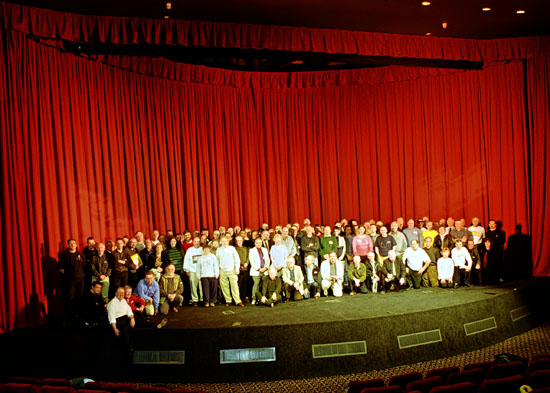 The
audience on stage. The
audience on stage.Next stop Darjeeling and a cup of tea. ”Seven Wonders” turned out to be, not surprisingly the “Pink Wonders of the World”. Tony Sloman, always at hand for an excellent intro, introduced the film. He even did a mid-film intro during the second break down. The prints shown in Bradford are very fragile, so breakdowns are the rule rather than the exception. It was interesting to see that film. It once was the opening attraction for Cinerama in Denmark. Even today it’s a wonderful piece of kitsch, but for the sophisticated Copenhagen audience in 1962, it was probably already dated. Before the next show it was time to announce the new member of the Academy of the Wide Screen Weekend. As mentioned earlier, Willem became the 2002 inducted member of the Academy. Skipped in 2001, the “Audience on the Stage picture” was back in 2002. As usual, the trick was to get as many members of the audience to go on stage and participate in the fun. Then yours truly, with assistance of Paul Rayton (he supplies the tripod and the direction of the crowd scene), one or two pictures are taken of the assembled audience standing in front of the cinerama screen. |
|||||||
"Cinerama Adventure" |
|||||||
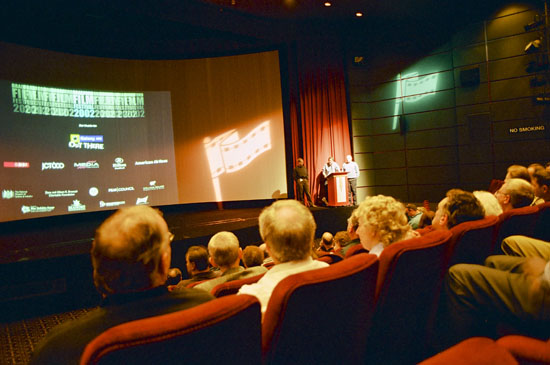 From
the audience point of view. From
the audience point of view.Producer Randy Gitsch introduced the film and told the story and reasoning behind the project. After the film, a huge round of applause was given to the people among the audience who had participated in making the documentary. And speaking personally, it was rather odd to see your own name on the credit roll. After the film, the audience was treated to newsreel footage from the premieres of “West”, “Windjammer” and “Grimm”. Next in line was some newly struck 3-strip material from the original negatives of “TIC”, “West”, “Cinerama Holiday” and “Search for Paradise”. What was the film like? Well it was bloody interesting and I can’t wait for the DVD with all the extras. The main disappointment for me was the complete absence of any hints of “Windjammer”. Although not an official Cinerama film, it was 3-strip and a first-person experience, and one of the best. Perhaps only rivaled by “How the West Was Won”. I can understand why Dave left out Kinopanorama, but “Windjammer” really ought to be in “Cinerama Adventure”. Dave and Greg answered questions after film. During production of the documentary, he told the audience, when he opened all the cans with 35mm negative, they all smelled of vinegar. The “Windjammer” negative was in plastic bags. He left the cans open so the films could breathe. All negatives, except “Seven Wonders” are still intact. “Seven Wonders” was recut to make a regular 35mm single strip film out of it. It would be next to impossible to put that film back together again. |
|||||||
What!, no ”Cineramacana”? |
|||||||
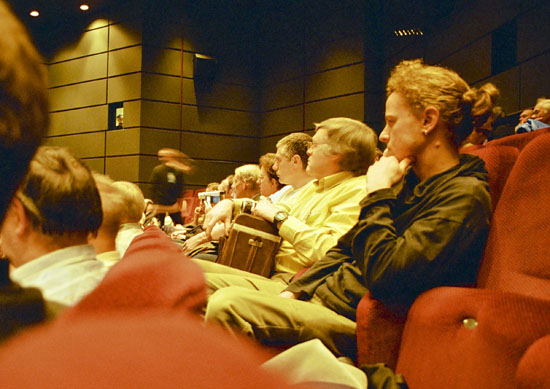 This
is what it is all about - the audience - you! This
is what it is all about - the audience - you!Unlike previous years, ”Cineramacana” Sunday morning was cancelled in favour of showing the rough cut of Dave Strohmaiers much awaited ”Cinerama Adventure”. Cineramacana is typically 2½ hours of short films and odd reels. Anything from old 70mm trailers and Cinerama breakdown films can be shown here. It’s a chance to show pieces of film that don’t fit in anywhere else. As it often turn out, members of the audience bring their own collectibles for the weekend. Usually it’s a director who brings his film to a film festival, but at WSW, it’s different. It’s the audience that’s in focus. Cineramacana is what makes WSW unique because it will give the audience a chance to see some very rare glimpses of some often forgotten films. The program is worked out in very close corporation with the projectionists as they are the “reel” masters of ceremonies. Due to the nature of Cineramacana, the final program is not published until just before show begins. The handout is literally typed up and photocopied in the morning, because we never know which rare items will turn up. The only drawback is the length of the show. It tends to go on and on because quite often, there are too many goodies to run. Cineramacana will be back in 2003. |
|||||||
Cinerama; the next 50 years (discussion) |
|||||||
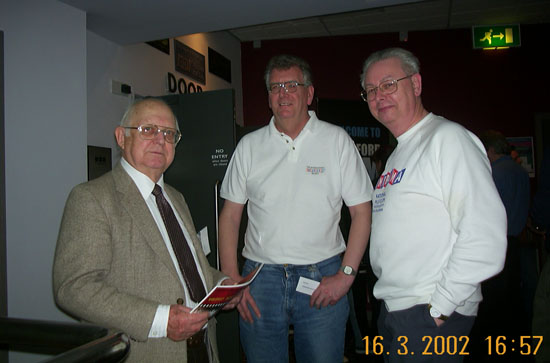 Dick
Babish and Cinerama twins Barrie Pick and David Page. Dick
Babish and Cinerama twins Barrie Pick and David Page.As Bill was still ailing Tony and I had to improvise because we didn’t have a clue as to what was going to happen. We asked the audience what they believed would happen the next 50 years and passed the microphone from person to person. It was a short discussion, less than 45 minutes. I’ve added some of the conclusions at the end of this article. One person asked why Pictureville´s Cinerama screen wasn’t a floor-to-ceiling installation as they were in the 50s and 60s. Willem Bouwmeester was at hand and told the audience that compromises in Pictureville had to be made to make room for the stage and the flat roller screen. Cineramacana the past years: |
|||||||
Burger King |
|
||||||
|
Before “Where Eagles Dare” Henrik and simply had to eat and for the first time this weekend, we turned to Burger King. I found Borden and Dick and invited them along for the fun of it. Both accepted and we soon found ourselves sitting in Bradford’s fast food “heaven“ talking about the events of the weekend. There’s nothing to report about the cuisine. Not very prestigious, but we all had a ball and a great laugh about the situation. |
|||||||
"Where Eagles Dare" in 70mm |
|||||||
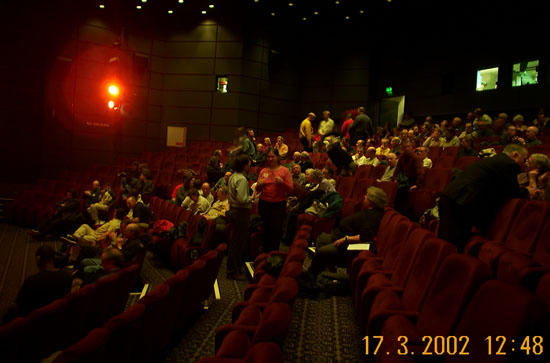 More
audience More
audienceIt was debated throughout the weekend if “Where Eagles Dare” should be shown on the curve or the flat screen. Being a favorite film of mine and not least Duncan in projection, we thought it should be on the curve. Hell, it was 70mm from the heydays of the curved screens. No matter if it was correct or not we thought it should be on the curve to add a flavor of 60s road show spectacularism. Everyone comes to Bradford to see films on the curve. At one point during the weekend I conducted a vote among the audience. The majority voted for curve and only 11 voted for the flat screen. The curve it was. It was terrific to see it again in 70mm. Who cared about cropping and the grainy look of the film as long as it was on the curve, and I suddenly realized, most of the film takes place at night. Tony introduced the film by reminiscing about the original release in London many years ago. Ron Goodwins music is splendid played out LOUDLY. Thanks to the Swedish Film Archive, the print was in good condition. Turner Classic Movies had sent us a “Behind the Scenes” featurette “On Location with Where Eagles Dare” which was shown before the film. Only 14 minutes, but certainly interesting to see. My wife and I visited the small town Werfen and especially Hohenwerfen castle in Austria in 1995. The actual castle is on top of a hill, and you can walk all the way up. There is no cable car to the castle except a very small one for groceries. Many other locations can also still be seen in real life. The railway station and the bridge are still there. ”Where Eagles Dare” is still unavailable on DVD but I hope it will be re-issued very soon. |
|||||||
Monday |
|||||||
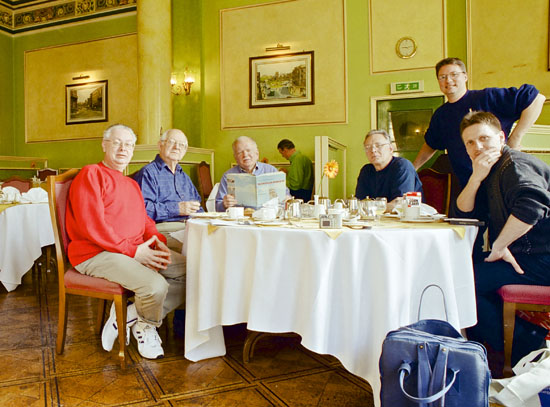 David
page (L), Dick, Borden, Paul, Thomas and Henrik David
page (L), Dick, Borden, Paul, Thomas and HenrikOur last breakfast at the hotel and we shared the table with Borden, Dick, David Page, Paul Rayton and Francois Carrin, as the late riser. It’s impossible to convey everything that happened. Borden and Dick signed autographs and were happy, cheerful and full of stories and anecdotes that morning. It was a morning to remember for years to come. They were like school boys, so excited and grateful about what had happened this weekend. Especially for the reception they received from the audience. The dedication for Cinerama was overwhelming. |
|||||||
Funny Girl |
|||||||
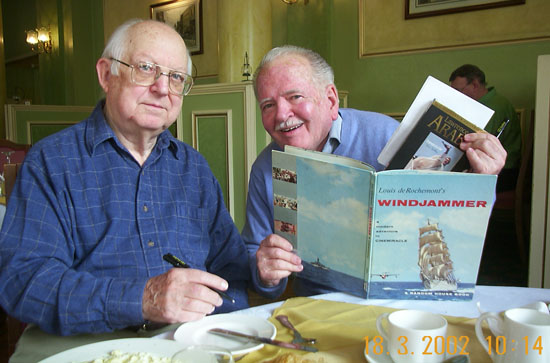 Dick
and Borden in Bradford 2002 Dick
and Borden in Bradford 2002Monday morning syndrome; I’m running down and there’s only one film left to see. The NMPFT is always closed on Mondays, except for the Wide Screen Weekend Monday morning presentation. “Funny Girl” restored in 35mm and 6 track SDDS digital sound with full overture, entr’acte, and exit music. The film is good, splendid songs and music, but it really should be in 70mm to give it the touch of magic, like the original release 30+ years ago. In Denmark the film was hugely successful and played many months in 70mm. In fact there were two 70mm prints of the film. By an odd coincidence I’d bought the film on DVD just two days earlier. After the farewells and goodbyes, Henrik and I left Bradford by train for Manchester airport. The weekend is now over and we are on the way home to develop pictures and reminisce about this weekend’s events. In the past 3 days we have taken part in something unique. Coming into touch with so many different people, interested in the same films as we, was a privilege. I’m proud to play a part in the planning and I’m always looking forward to come back. How to sum up some headlines from the weekend? It was Cinerama’s 50th birthday and Cinerama of course being the ”mother of all wide screen systems” we managed to present “This is Cinerama”, “Cinerama Holiday”, “How The West Was Won” and “Seven Wonders of the World” to represent an era of cinema which has long since disappeared. This unique event was witnessed by many fans who came in from all over the globe to be a part of that. Although Cinerama IS a familiar word among the audience, it is NOT a household name among the general public. With good reason. The message from Dave Strohmaier during his “Cinerama Adventure” introduction was, that even “The Cinerama Dome” in Los Angeles is not a household name and “nobody” knows where it is. It is now up to the audience, NMPFT, Cinerama Dome in LA and the Seattle Cinerama to boost new life into Cinerama. The efforts to date by Willem Bouwmeester, John Harvey, National Museum og Photography, Film & Television, Dave Strohmaier, Pacific Theatres, Paul Allen, The International Cinerama Society and many others to give the format the “breath of life”, have been a colossal effort which must be applauded. It’s now the audience responsibility to write letters to movie companies and ask for restorations and specifically in 70mm, Cinemiracle and Cinerama. The audience must react to threatened closures of unique or special cinemas. The task of showing Cinerama and keeping it as a “front row experience” for the next 50 years is not only ours, but our kids. And it’s the preservation for them that’s so important now. I’ll bring my daughter for 2003’s Wide Screen Weekend. |
|||||||
|
Go: back
- top - back issues
- news index Updated 22-01-25 |
|
